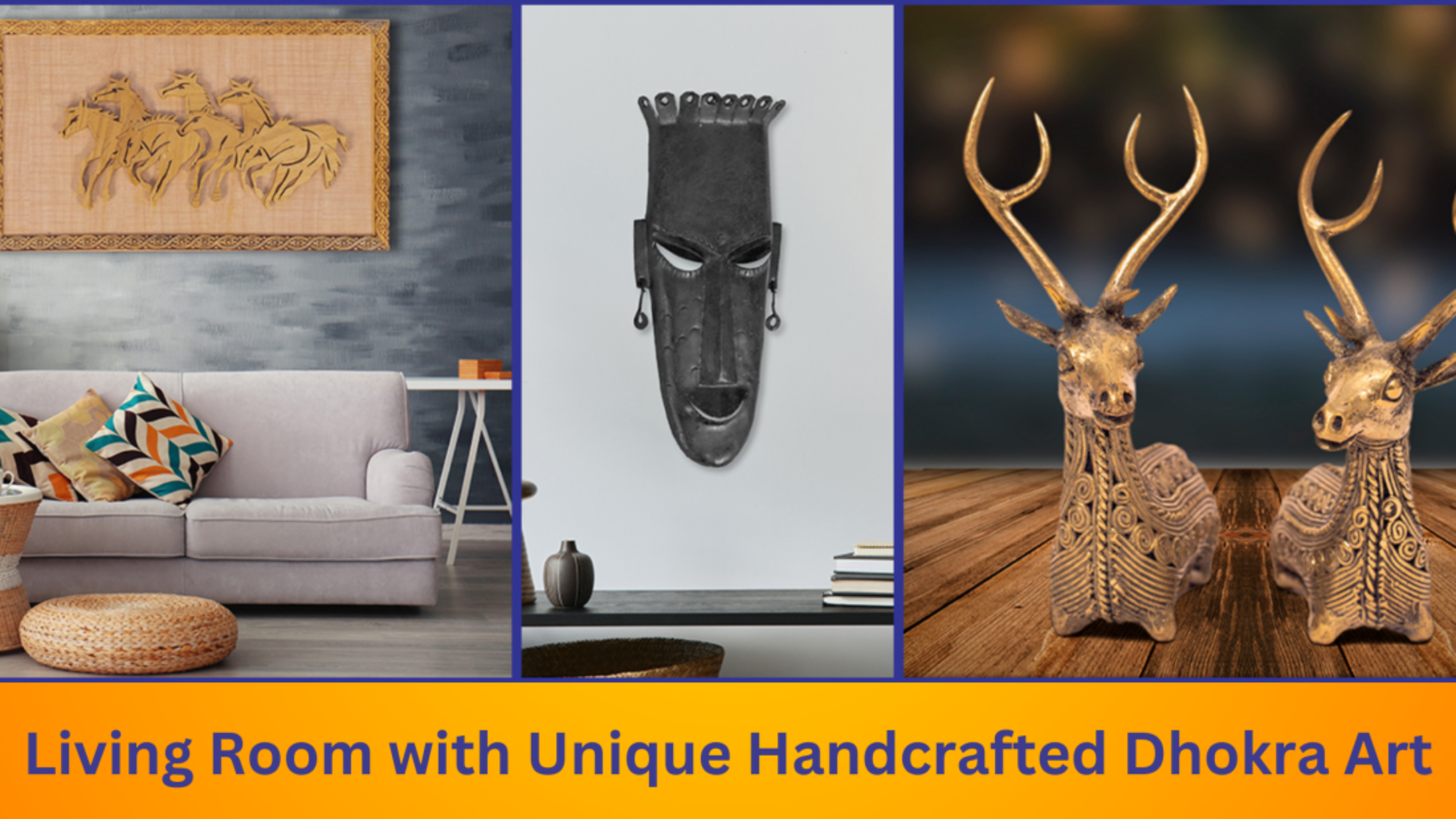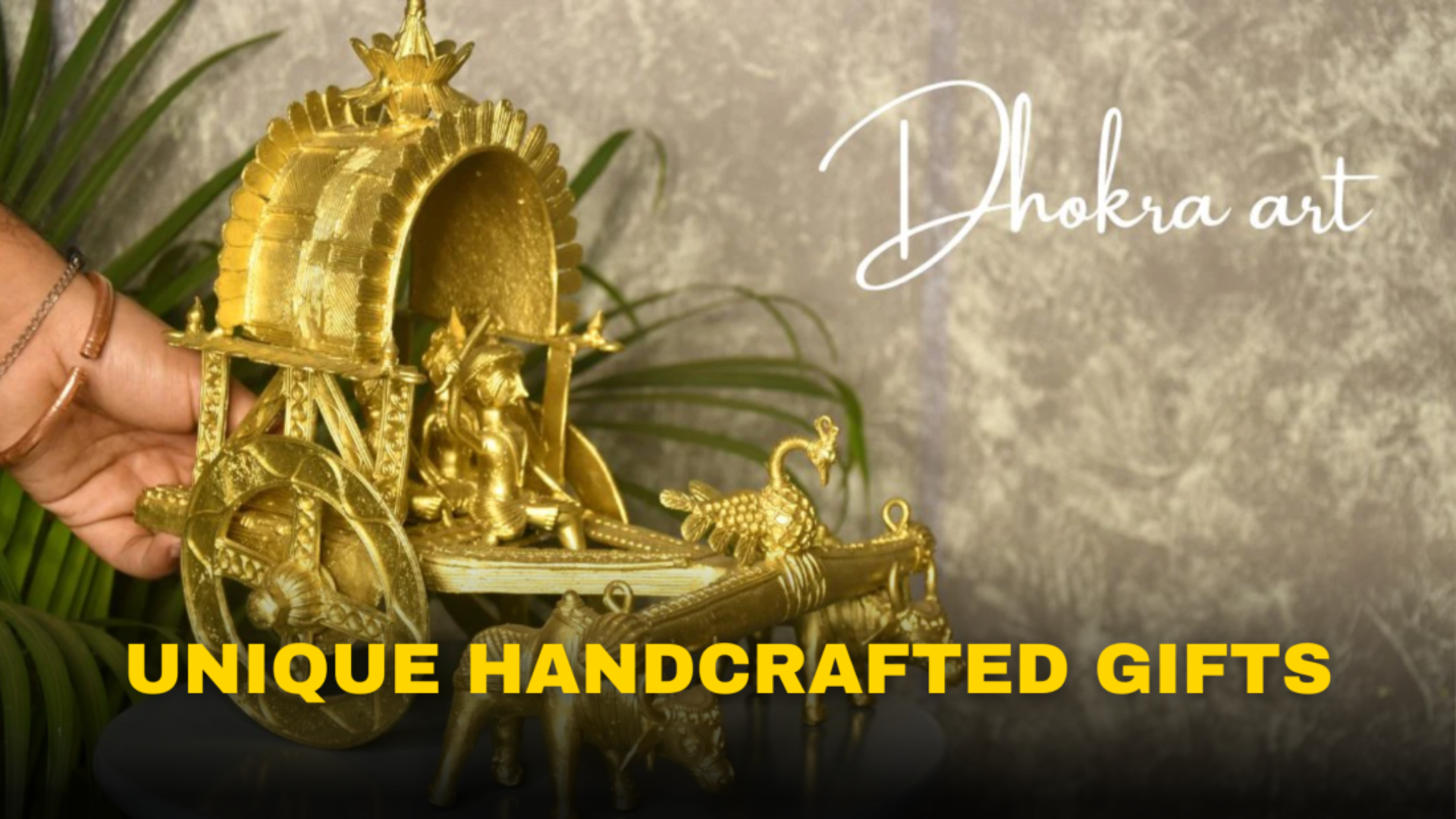Dhokra art is a timeless metal craft tradition that dates back over 4,000 years. Originating in the tribal belts of India, particularly in states like West Bengal, Chhattisgarh, Odisha, and Jharkhand, this unique art form is renowned for its intricate designs and sustainable techniques. It employs the ancient “lost wax casting” process to create beautiful sculptures and utility items.
Dhokra art has gained immense recognition in the modern world, not just for its aesthetic value but also for the way it represents sustainable craftsmanship. With each piece telling a unique story, Dhokra has become a prized possession among collectors and enthusiasts. This blog delves deep into the nuances of this magnificent art form, exploring every aspect that makes it truly extraordinary.
History and Origins of Dhokra Art
The roots of Dhokra art lie in the Indus Valley Civilization, where metal objects made using the lost wax casting method were unearthed. The dancing girl of Mohenjo-daro is a notable example of this technique. Over time, the tribal communities, such as the Dhokra Damar, carried this legacy forward, preserving the craft and evolving its designs.
The historical significance of Dhokra art is profound. The craft is believed to have been passed down through generations, with each artisan adding their creative flair to the process. In ancient times, Dhokra artifacts were used for religious rituals, trade, and even as currency. The tradition has survived the test of time, adapting to changing preferences while retaining its core identity.

The Process of Lost Wax Casting
The defining feature of Dhokra art is the “lost wax casting” process. This multi-step method involves creating a clay model, coating it with wax, adding intricate details, and then enclosing it in another layer of clay. When heated, the wax melts away, leaving a cavity into which molten metal is poured. After cooling, the outer clay mold is broken to reveal the finished product.
This meticulous process ensures that no two Dhokra pieces are identical, making each artifact a one-of-a-kind masterpiece. The attention to detail and the skill required to execute this technique highlight the expertise of Dhokra artisans. The process is labor-intensive, often taking weeks or even months to complete a single piece.
Materials Used in Dhokra Art
Artisans primarily use natural materials like beeswax, resin, and clay. The metal used is often brass or bronze. The eco-friendly aspect of Dhokra art lies in its minimal reliance on industrial materials, making it a sustainable and environmentally conscious craft.
The use of natural materials not only adds to the charm of Dhokra artifacts but also aligns with the global shift toward sustainable living. By choosing Dhokra art, buyers contribute to the preservation of traditional craftsmanship and support eco-friendly practices.

Unique Features of Dhokra Art
Dhokra artifacts are known for their rustic and raw appearance, achieved through the detailed engraving and handwork of artisans. Common motifs include animals, tribal deities, and everyday life scenes. The non-replicable nature of each piece adds to its uniqueness.
The charm of Dhokra art lies in its imperfections, which reflect the human touch behind every creation. These imperfections are celebrated as a testament to the artisan’s dedication and creativity. Whether it’s a delicate figurine or a functional item, each Dhokra piece carries a distinct identity.
Regional Variations in Dhokra Art
Dhokra art varies across different regions. For instance, Bastar in Chhattisgarh is famous for its tribal themes, while West Bengal’s artisans often depict traditional tales and mythology. Despite regional differences, the essence of Dhokra art remains consistent.
The regional diversity of Dhokra art adds to its appeal, offering a wide range of styles and themes for collectors to explore. Each region’s unique interpretation of Dhokra art reflects its cultural heritage and local traditions, making the craft a true representation of India’s diversity.
Cultural Significance of Dhokra Art
Dhokra art holds immense cultural value in India. It is often used in rituals, festivals, and as gifts. Many pieces, such as lamps, idols, and jewelry, have deep symbolic meanings, making them integral to local traditions.
In tribal communities, Dhokra art serves as more than just a craft; it is a way of life. Artisans often draw inspiration from their surroundings, depicting scenes of nature, mythology, and daily life. These creations not only showcase their artistic talent but also preserve their cultural narratives.
Role of Dhokra Art in Modern Decor
Today, Dhokra art has found a place in modern interior design. From decorative sculptures to functional items like trays and bowls, it adds a touch of ethnicity and elegance to contemporary spaces. Artline Creation often integrates Dhokra artifacts into its offerings, catering to clients seeking heritage-inspired decor.
The versatility of Dhokra art makes it suitable for a variety of settings, from traditional homes to minimalist modern spaces. Its timeless appeal ensures that it remains a popular choice among interior designers and homeowners alike.
Challenges Faced by Dhokra Artisans
Dhokra art holds immense cultural value in India. It is often used in rituals, festivals, and as gifts. Many pieces, such as lamps, idols, and jewelry, have deep symbolic meanings, making them integral to local traditions.
In tribal communities, Dhokra art serves as more than just a craft; it is a way of life. Artisans often draw inspiration from their surroundings, depicting scenes of nature, mythology, and daily life. These creations not only showcase their artistic talent but also preserve their cultural narratives.
Role of Dhokra Art in Modern Decor
Today, Dhokra art has found a place in modern interior design. From decorative sculptures to functional items like trays and bowls, it adds a touch of ethnicity and elegance to contemporary spaces. Artline Creation often integrates Dhokra artifacts into its offerings, catering to clients seeking heritage-inspired decor.
The versatility of Dhokra art makes it suitable for a variety of settings, from traditional homes to minimalist modern spaces. Its timeless appeal ensures that it remains a popular choice among interior designers and homeowners alike.
Challenges Faced by Dhokra Artisans
Despite its rich heritage, Dhokra art faces challenges such as declining patronage, rising material costs, and competition from machine-made goods. Many artisans struggle to sustain their livelihoods due to limited access to markets and resources.
The lack of awareness about the value of Dhokra art further exacerbates these challenges. Efforts to promote the craft and support artisans are crucial to ensuring its survival. Organizations like Artline Creation are stepping up to address these issues by creating platforms for artisans to showcase their work.
Government Initiatives to Promote Dhokra Art
The Indian government has introduced various schemes to support Dhokra artisans, including GI (Geographical Indication) tags, financial aid, and training programs. These initiatives aim to preserve this ancient craft and improve the socio-economic conditions of artisans.
By providing artisans with the resources and recognition they need, these initiatives play a vital role in sustaining the Dhokra tradition. The GI tag, in particular, has helped establish the authenticity and uniqueness of Dhokra art, making it more appealing to buyers.
The Role of Artline Creation in Supporting Dhokra Art
Artline Creation takes pride in collaborating with Dhokra artisans to bring this traditional art form to a global audience. By incorporating Dhokra artifacts into its product line, the company not only supports artisans but also promotes Indian heritage.
Through its efforts, Artline Creation has helped bridge the gap between traditional artisans and modern consumers. By providing a platform for Dhokra art, the company ensures that this ancient craft continues to thrive in the modern world.
Famous Dhokra Artifacts
Some of the most iconic Dhokra artifacts include the tribal figurines of Bastar, intricately designed lamps, and jewelry items. These pieces are cherished for their aesthetic appeal and craftsmanship.
Each artifact tells a story, making it a meaningful addition to any collection. Whether it’s a simple decorative item or a complex sculpture, Dhokra art never fails to captivate with its charm and elegance.
How to Identify Authentic Dhokra Art
Authentic Dhokra art can be distinguished by its hand-crafted imperfections, intricate detailing, and raw finish. Buyers should also look for certifications or purchase from reputable sellers like Artline Creation to ensure authenticity.
The authenticity of Dhokra art adds to its value, making it a worthwhile investment. By choosing genuine pieces, buyers not only acquire a beautiful artifact but also support the artisans who create them.
Maintenance Tips for Dhokra Artifacts
To maintain the beauty of Dhokra artifacts, regular dusting with a soft cloth is recommended. Avoid using harsh chemicals, and periodically polish the metal with a mixture of lemon and water to retain its shine.
Proper care ensures that Dhokra artifacts retain their charm for years to come. With minimal effort, these timeless pieces can continue to enhance the beauty of any space.
Incorporating Dhokra Art in Everyday Life
Dhokra art is versatile and can be used in various settings, from home decor to personal accessories. Its timeless appeal makes it suitable for both traditional and contemporary lifestyles.
By integrating Dhokra art into daily life, buyers can enjoy its beauty and functionality while celebrating a rich cultural heritage. From jewelry to kitchenware, the possibilities are endless.
Global Recognition of Dhokra Art
Dhokra art has gained international acclaim for its artistic value and sustainability. Many collectors and museums worldwide showcase these artifacts, highlighting their cultural and historical importance.
The global appeal of Dhokra art is a testament to its universal charm. As more people recognize its value, the craft continues to gain prominence on the world stage.
The Future of Dhokra Art
With increased awareness and support, the future of Dhokra art looks promising. Organizations like Artline Creation are playing a pivotal role in bridging the gap between artisans and modern consumers, ensuring the longevity of this exquisite craft.
The efforts to preserve and promote Dhokra art are a collective responsibility. By supporting this craft, buyers and organizations can contribute to its survival and growth.
Frequently Asked Questions About Dhokra Art
What is Dhokra Art?
Dhokra art is an ancient Indian metal casting craft using the lost wax technique, known for its intricate and rustic designs.
Where is Dhokra Art Practiced?
Dhokra art is primarily practiced in West Bengal, Chhattisgarh, Odisha, and Jharkhand, among other regions in India.
How Can I Buy Authentic Dhokra Artifacts?
Authentic Dhokra artifacts can be purchased from reputed sellers like Artline Creation or at government-recognized emporiums.
Is Dhokra Art Eco-Friendly?
Yes, Dhokra art is eco-friendly as it uses natural materials and traditional techniques that have minimal environmental impact.
Can Dhokra Art Be Customized?
Many artisans and companies, including Artline Creation, offer customization options for Dhokra artifacts to meet specific design preferences.








